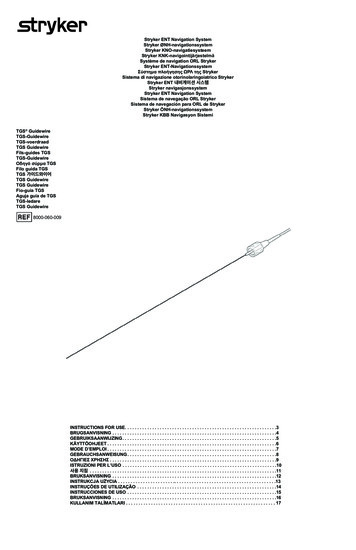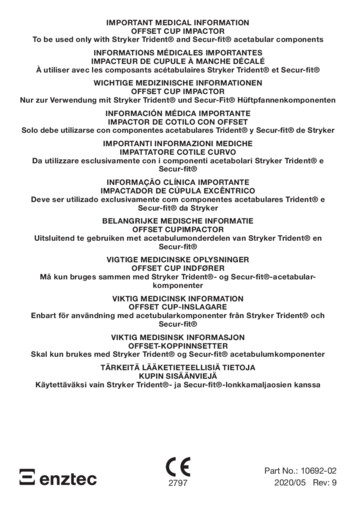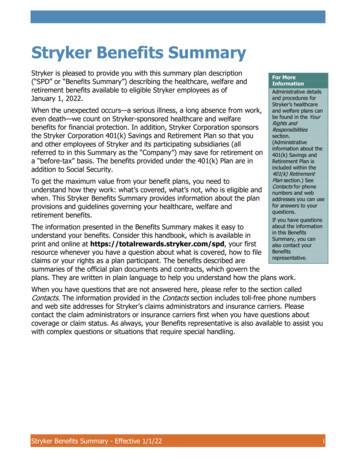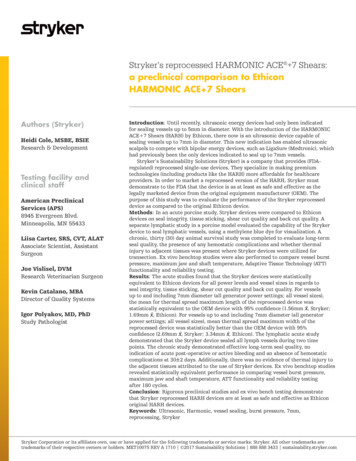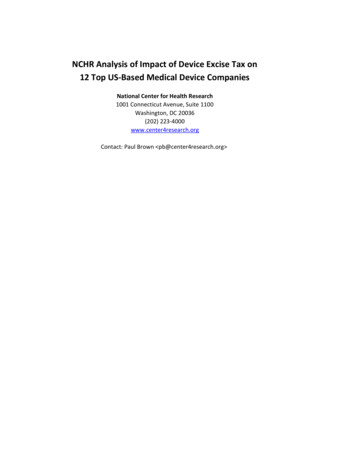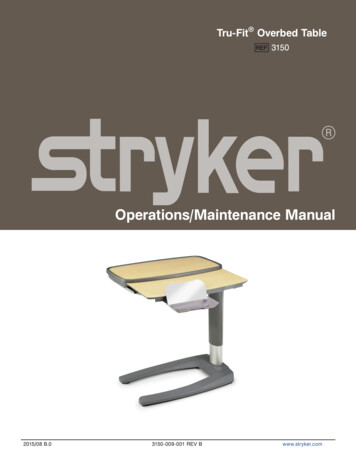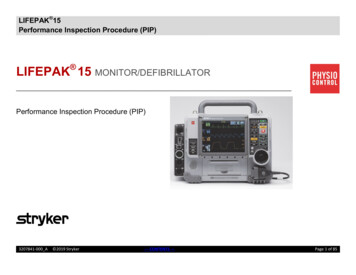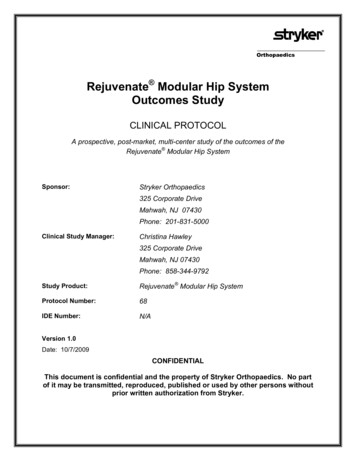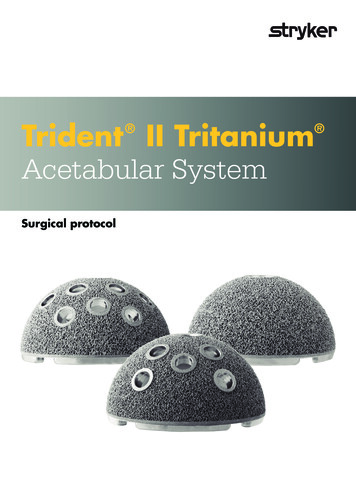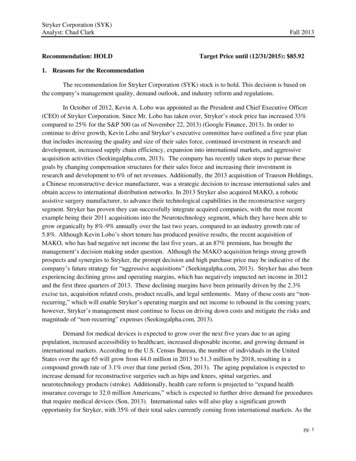
Transcription
Stryker Corporation (SYK)Analyst: Chad ClarkRecommendation: HOLDFall 2013Target Price until (12/31/2015): 85.921. Reasons for the RecommendationThe recommendation for Stryker Corporation (SYK) stock is to hold. This decision is based onthe company’s management quality, demand outlook, and industry reform and regulations.In October of 2012, Kevin A. Lobo was appointed as the President and Chief Executive Officer(CEO) of Stryker Corporation. Since Mr. Lobo has taken over, Stryker’s stock price has increased 33%compared to 25% for the S&P 500 (as of November 22, 2013) (Google Finance, 2013). In order tocontinue to drive growth, Kevin Lobo and Stryker’s executive committee have outlined a five year planthat includes increasing the quality and size of their sales force, continued investment in research anddevelopment, increased supply chain efficiency, expansion into international markets, and aggressiveacquisition activities (Seekingalpha.com, 2013). The company has recently taken steps to pursue thesegoals by changing compensation structures for their sales force and increasing their investment inresearch and development to 6% of net revenues. Additionally, the 2013 acquisition of Trauson Holdings,a Chinese reconstructive device manufacturer, was a strategic decision to increase international sales andobtain access to international distribution networks. In 2013 Stryker also acquired MAKO, a roboticassistive surgery manufacturer, to advance their technological capabilities in the reconstructive surgerysegment. Stryker has proven they can successfully integrate acquired companies, with the most recentexample being their 2011 acquisitions into the Neurotechnology segment, which they have been able togrow organically by 8%-9% annually over the last two years, compared to an industry growth rate of5.8%. Although Kevin Lobo’s short tenure has produced positive results, the recent acquisition ofMAKO, who has had negative net income the last five years, at an 87% premium, has brought themanagement’s decision making under question. Although the MAKO acquisition brings strong growthprospects and synergies to Stryker, the prompt decision and high purchase price may be indicative of thecompany’s future strategy for “aggressive acquisitions” (Seekingalpha.com, 2013). Stryker has also beenexperiencing declining gross and operating margins, which has negatively impacted net income in 2012and the first three quarters of 2013. These declining margins have been primarily driven by the 2.3%excise tax, acquisition related costs, product recalls, and legal settlements. Many of these costs are “nonrecurring,” which will enable Stryker’s operating margin and net income to rebound in the coming years;however, Stryker’s management must continue to focus on driving down costs and mitigate the risks andmagnitude of “non-recurring” expenses (Seekingalpha.com, 2013).Demand for medical devices is expected to grow over the next five years due to an agingpopulation, increased accessibility to healthcare, increased disposable income, and growing demand ininternational markets. According to the U.S. Census Bureau, the number of individuals in the UnitedStates over the age 65 will grow from 44.0 million in 2013 to 51.3 million by 2018, resulting in acompound growth rate of 3.1% over that time period (Son, 2013). The aging population is expected toincrease demand for reconstructive surgeries such as hips and knees, spinal surgeries, andneurotechnology products (stroke). Additionally, health care reform is projected to “expand healthinsurance coverage to 32.0 million Americans,” which is expected to further drive demand for proceduresthat require medical devices (Son, 2013). International sales will also play a significant growthopportunity for Stryker, with 35% of their total sales currently coming from international markets. As thepg. 1
Stryker Corporation (SYK)Analyst: Chad ClarkFall 2013economies and the quality of medicine around the world continue to advance, demand for medical devicesinternationally will continue to grow, especially in developing countries such as China and India, makingthe 2013 Trauson acquisition a key component for Stryker’s international success. Disposable income isanother factor that may positively impact the demand for medical devices, with disposable incomeexpected to increase by 2.4% over the next five years (Son, 2013). Higher disposable income will likelyincrease demand for discretionary surgeries, such as knees. Due to these various factors, demand formedical devices is expected to continue to grow over the next five years.Although demand for medical devices looks strong in the coming years, and Stryker seems to bewell positioned to capitalize on the expected growth, uncertainties such as healthcare reform and medicaldevice regulations could slow the overall performance of the industry and ultimately impact Stryker’sgrowth prospects. Healthcare reform within the United States has already negatively impacted themedical device industry by applying a 2.3% excise tax on medical devices. This tax is not likely to berepealed and uncertainty remains whether the tax will increase or decrease in the coming years. TheUnited States healthcare reform has also resulted in pricing pressures, which will continue to increase ashealthcare providers continue to consolidate, the payment of healthcare expenses shifts to thegovernment, and new laws and regulations develop regarding product pricing and insurancereimbursements. Additionally, demand for stricter regulation of medical devices may pose a threat to theoverall growth prospects of the industry. In the United States the FDA regulates all medical devices.Stricter regulations, both within the United States and internationally, pose a significant threat to thisindustry in terms of the cost to develop products, delayed time to market, and an increase in the numberof product recalls (Seekingalpha.com, 2013).Overall, Stryker has both positive and negative aspects affecting the long term outlook of thecompany’s stock. Stryker’s current management has proven to deliver positive results in the short term,yet recent decisions and declining margins will continue to challenge Stryker’s strength of managementand their ability to deliver results. Demand for medical devices looks positive in the coming years, butmay be offset by uncertainty’s regarding healthcare reform and medical device regulations. These factorsare the primary reasons for the hold recommendation of Stryker’s stock.The market consensus has currently priced in the all of the above factors, with the primarydifference being the magnitude in which each factor is expected to impact the performance of Stryker’sstock. Expectations for strong sales growth and acquisition related activity in the reconstructive andneurotechnology product segments likely exceed those of the market consensus. Expectations are likely tobe in line with the market in terms of MedSurg growth and Stryker’s operating margins.pg. 2
Stryker Corporation (SYK)Analyst: Chad ClarkFall 20132. Company AnalysisFounded in 1941 in Kalamazoo, Michigan, Stryker Corporation is a publically traded company on theNew York Stock Exchange (NYSE) under the ticker symbol “SYK”. Stryker is in the medical devicesindustry where they manufacture, market, and sell products in the Reconstructive, MedSurg, andNeurotechnology and Spine product segments. Stryker is “one of the world’s leading medical technologycompanies” with 2012 revenues of 8.7 billion and net earnings of 1.3 billion (Stryker Corporation,2012).Stryker’s largest product segment, Reconstructive, accounts for roughly 44% of the company’s totalrevenues. Within this product segment, knees account for 35% of total sales, with hips accounting for32%. Trauma, extremities, and other account for the remaining 33% of reconstructive sales. Stryker hasan estimated 20% market share in the hip and knee product segment and 17% market share in trauma,extremities and other (Stryker Fact Book, 2012). Stryker has made multiple acquisitions in this productsegment, most recently with the 2013 acquisitions of Trauson Holdings, a Chinese manufacture of lowcost reconstructive products, and MAKO, a reconstructive manufacturer with robotic assisting surgicaltechnologies. Historically, Stryker has been able to grow this product segment an average of 6.7%annually, which was due to a strong sales force and competitive product offerings that drove organicgrowth. Acquisition activities have contributed a small percentage of growth, although inorganically.Stryker will continue to aggressively pursue acquisitions in this product segment as well as increase thecompetitiveness and mix of products through continued investment in research and development (StrykerCorporation, 2013). Stryker’s reconstructive segment is anticipated to be one of the company’s primarygrowth areas through 2018 due to the increased demand for these products, with expectations for thissegment to grow 7% annually (organic) through 2018 and 7.4% including acquisitions. This growth willprimarily be driven by increased product offerings and strong demand for knee and hip surgeries as wellas continued advancements in trauma and extremities products, which will increase Stryker’s marketshare in this segment.Stryker’s second largest product segment, MedSurg, accounts for roughly 37% of the company’s totalrevenues. Within the MedSurg product segment, Instruments account for 39% of MedSurg sales withEndoscopy, Medical Equipment, and Other accounting for 34%, 21%, and 6%, respectively (StrykerCorporation, 2013). Stryker’s MedSurg segment has grown at an average of 12% annually over the last 10years, driven primarily by acquisition related activities. Most recently in 2012 and through the first threequarters of 2013, Stryker has only seen this segment grow by an average of 2.3%. This slow growth isprimarily due to minimal acquisition related activities, the stagnation of instrument related sales, and therecall of their “Neptune Waste Management System”, which is expected to return to the market in early2014 (Stryker Corporation, 2013). Over the next five years, this product segment is expected to remainfairly stable with annual organic growth of 2.2%. This stable growth will be negatively impacted bylower capital expenditures at hospitals and other healthcare providers and positively impacted by the reintroduction of the “Neptune Waste Management System” in 2014.Stryker’s smallest, yet fastest growing product segment is Neurotechnology and Spine, whichaccounts for roughly 19% of total sales. Neurotechnology contributes roughly 54% of this segments sales,with Spine contributing the remaining 46%. Stryker acquired their way into the Neurotechnologypg. 3
Stryker Corporation (SYK)Analyst: Chad ClarkFall 2013segment in 2011 with the acquisitions of Concentric Medical and the Neurovascular division of BostonScientific. Since acquiring their way into the Neurotechnology segment, Stryker has been able to growsales organically by 8.5% in 2012 and an average of 9.8% in the first three quarters of 2013 (StrykerCorporation, 2013). Neurotechnology and Spine sales are expected to continue to grow organically by7.5% in 2014, gradually declining to 4.5% growth in 2018. This growth will primarily be driven byinnovative product offerings that will result in market share gains, but is expected to gradually slow to arate closer to this segments total market growth by 2018.3. Industry AnalysisAccording to the NAICS Code Grouping of the U.S. Department of Commerce, the medical deviceindustry encompasses a broad range of product categories such as diagnostic reagents, electro medicaland electrotherapeutic devices and equipment, irradiation apparatus, surgical and medical instruments,surgical appliances and supplies, dental equipment and supplies, ophthalmic goods, and dentallaboratories (Richard K. Miller &Associates, 2013). This industry had sales of 135.9 billion in 2012(Richard K. Miller &Associates, 2013). The largest product segments in the medical device industryinclude surgical appliances and supplies and surgical and medical instruments, which together combinedfor 2012 sales of 91.7 billion (Son, 2013). Within these product categories lie the three main productsegments in which Stryker Corporation currently competes: Reconstructive, MedSurg, andNeurotechnology and Spine. Customers of these products include primary care and specialist doctors,hospitals, healthcare purchasing organizations, and other medical or surgical providers (StrykerCorporation, 2012).The reconstructive product segment had a market size of 25.2 billion in 2012 (Stryker FactBook, 2012). This product segment includes reconstructive implants such as knees and hips, as well asproducts for sports, extremities, and trauma surgeries, and orthobiologics. Hip and knee products are a 14 billion industry with Zimmer, Johnson & Johnson, and Stryker claiming 65% of this market, withmarket shares of 24%, 21%, and 20%, respectively. Sports, extremities and trauma surgeries are a 5.9billion industry with Johnson & Johnson claiming a 40% market share. Other market leaders in thisproduct category include Stryker (17%), Biomet (8%), Smith and Nephew (8%), and Zimmer (4%).Orthobiologics account for the remaining 5.3 billion in the reconstructive product category withMedtronic and Johnson & Johnson claiming 15% and 13% of the market, respectively. Stryker has anestimated 3% market share in the orthobiologics category. Overall, the reconstructive segment grew 2%in 2012 (Stryker Fact Book, 2012).The MedSurg product segment had 2012 sales of 36.3 billion in 2012, with year over yeargrowth of 3% (Stryker Fact Book, 2012). Products in this segment include endoscopy, which are“minimally invasive surgical solutions”, patient handling equipment, operating room equipment, and thereprocessing and remanufacturing of equipment (Stryker Corporation, 2012). Endoscopy accounts for74% of the MedSurg segment with 2012 sales of 26.8 billion (Stryker Corporation, 2012). Theendoscopy market leaders include Johnson & Johnson, Olympus, and Covidien, with market shares of19%, 17%, and 14%, respectively. Stryker claimed a 4% market share in endoscopy in 2012. Patienthandling equipment is the second largest MedSurg product category with 2012 sales of 4.5 billion withHill- Rom and Stryker being the obvious market leaders with market shares of 28% and 16%,pg. 4
Stryker Corporation (SYK)Analyst: Chad ClarkFall 2013respectively. Stryker is the clear cut market leader in operating room equipment, claiming 35% of the 3.3 billion market, with Zimmer and Medtronic claiming 11% and 6%, respectively. Reprocessing andremanufacturing is the smallest MedSurg segment with sales of 1.8 billion with Stryker and Johnson &Johnson claiming the majority of the market (Stryker Fact Book, 2012).Neurotechnology and Spine had 2012 sales of 11.0 billion. Spine accounted for the majority ofthis segment with 2012 sales of 7.6 billion. Spine products include “spinal implant products includingcervical, thoracolumbar and inter body systems used in spinal injury, deformity, and degenerativetherapies” (Stryker Corporation, 2012). The leading companies in this product category includeMedtronic, Johnson & Johnson, Stryker, and Zimmer, with the market leader being Medtronic, whoclaimed an estimated 31% of this market in 2012. Johnson & Johnson, Stryker, and Zimmer hadestimated market shares of 23%, 8%, and 3%, respectively. Spine sales were down 1% in 2012.Neurotechnology products had 2012 sales of 3.4 billion with Stryker claiming 24% market share.Johnson & Johnson and Medtronic had market shares of 18% and 15%, respectively (Stryker Fact Book,2012). Neurotechnology sales grew 5.8% in 2012 (Stryker Fact Book, 2012).Overall, the medical devices industry is expected to grow by 3.9% annually in the U.S over thenext five years (2013-2018). This growth will primarily be driven by an aging population, increasedaccessibility to medical care, and higher disposable income (Son, 2013). The medical device industry isalso likely to continue to consolidate in order to benefit from economies of scale, which will distribute thehigh fixed costs across multiple products, ultimately increasing profit margins and driving down productcosts. Healthcare reform is likely to be the greatest driver of market consolidation due to actions such asincreased taxes and potential pricing pressure, making it difficult for smaller firms to compete (Son,2013).pg. 5
Stryker Corporation (SYK)Analyst: Chad ClarkFall 2013Appendix: Inputs into valuation using multiples* Analyst's own calculations. Source of basic data: Stryker Corporation 10-K; Yahoo! Financepg. 6
Stryker Corporation (SYK)Analyst: Chad ClarkFall 2013Sources:Stryker Corporation. (2012). Stryker Corporation Form 10-K. Kalamazoo, MI;.Stryker Corporation. (2012). Stryker Corporation Fact Book 2012. Kalamazoo, MI;.Richard K. Miller & Associates. (2013). Healthcare Business Market Research Handbook 2013-2014.Loganville, GA;.Anna Son. (2013). IBIS World Industry Report 33911a Medical Instruments & Supply Manufacturing inthe US. Retrieved /reports/us/industry/default.aspx?entid 881;.Stryker Corporation. (March, 2013). Stryker Corporation Form 10-Q. Kalamazoo, MI;.Stryker Corporation. (June, 2013). Stryker Corporation Form 10-Q. Kalamazoo, MI;.SeekingAlpha.com. (July, 2013). Stryker Corporation (SYK) Discusses Q2 2013 Results- Earnings CallTranscripts. Retrieved from rporation-hosts-analystmeeting-transcript?all true&find SYK%2B ;.Stryker Corporation. (September, 2013). Stryker Corporation Form 10-Q. Kalamazoo, MI;.SeekingAlpha.com. (October, 2013). Stryker Corporation (SYK) Discusses Q3 2013 Results- EarningsCall Transcripts. Retrieved from anscript;.Google Finance. (October, 2013). Retrieved fromhttp://www.google.com/finance?q NYSE%3ASYK&ei 9kRnUpCwCsOsqgHJAg.pg. 7
introduction of the "Neptune Waste Management System" in 2014. Stryker's smallest, yet fastest growing product segment is Neurotechnology and Spine, which accounts for roughly 19% of total sales. Neurotechnology contributes roughly 54% of this segments sales, with Spine contributing the remaining 46%.
